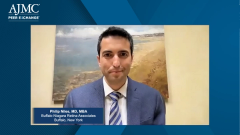
Goals of Therapy for Wet Age-Related Macular Degeneration
Philip Niles, MD, MBA; Kevin U. Stephens, Sr., JD, MD; Jim Kenney, RPh, MBA; and Nicholas G. Anderson, MD, review goals of therapy for patients with wet age-related macular degeneration (AMD) and discuss a health plan perspective for the management of therapy.
Episodes in this series

Jim Kenney, RPh, MBA: In our next section we’re going to talk about the treatment and management of wet AMD [age-related macular degeneration] and DME [diabetic macular edema]. The first question is what are the goals of therapy for patients with wet AMD?
Philip Niles, MD, MBA: For me, the goals of therapy for patients with wet macular degeneration are to obviously get the best visual outcomes that we can. It’s to recover vision that was lost and hopefully retain any vision without losing more. We measure vision in different ways, but one of the most common ways is the patient’s best-corrected visual acuity [BVCA], what they’re able to see on a classic eye chart with the best pair of glasses. The numbers people are used to hearing are like 20/20. But patients with macular degeneration can lose vision. They can hopefully gain vision if they have wet macular degeneration and the treatment’s going well, and so we hope to gain lines of vision. What does that mean practically speaking? When you think of vision that you would expect, that’s 20/20. But I think the way to look at it beyond that is with a change in every 3 lines or so. So 3 lines below the 20/20 line is about 20/40, which is when you’re on the threshold of being able to have your DMV [Department of Motor Vehicles] form signed off on by your eye care provider. Then 3 lines below that might be 20/70 or so, and that’s at the point where you may or may not be able to watch TV across the room. With each 3 lines further, there’s further loss of function. Every line of vision is important, and patients recognize, I would say, each line. In terms of overall how are we monitoring our patients, it’s really on the holistic patient, how are they doing, but also on their visual acuity as measured on the chart.
Jim Kenney, RPh, MBA: Do you find health plans look for improvements in BVCA as requirements to continue therapy in these patients?
Philip Niles, MD, MBA: Not so much. From a clinician standpoint, what we’re looking at really is every visit they come in, they get a scan called an OCT, an optical coherence tomography. And that shows us the disease activity. When that’s going well and when the OCT looks good, then we feel like our treatments are working. I haven’t so much encountered a requirement or a threshold that must be met in order to continue treatment for a patient.
Kevin U. Stephens, Sr., JD, MD: I can jump in too and say that from a health plan perspective, it’s tough because it’s a chronic or long-term treatment and long-term disease. After one treatment you typically will not—you can correct me if I’m wrong—but you don’t see marked improvement or not, unless there’s some other factor that is taking place here. For the most part, you’re in it for the long haul. If I’m not mistaken, many times it lasts up to 2 years or so. That brings up another point though, particular in commercial plans, your employer sometimes can change plans from one to the next, and that creates complications because you’re switching plans and switching benefits and so forth. It’s a very difficult disease process to monitor and manage because of the specific nuances in this pathology.
Nicholas G. Anderson, MD: I agree with Dr. Niles and Dr. Stephens. I think it’s very important for these patients to set expectations on the front end. Many of these patients may have had cataract surgery 10 years prior, and the expectation for that surgery was 20/20 vision. With wet macular degeneration, that is certainly not the expectation or the goal even of therapy. Our goal is to maintain functional vision to the greatest extent possible, for the greatest duration possible. And as Dr. Stephens mentioned, our goal may not be improvement in the vision. That’s very important to set that expectation up front, that in my mind, successful therapy is maintaining the patient’s vision. It’s great, we do see improvement in vision in many patients, but certainly not all patients. And so we really want to set that expectation that we’re trying to maintain the vision and prevent further deterioration.
Jim, in terms for your question with specific visual acuity levels, I think it’s also important to recognize how important even a lower level of vision is to my patients. Any of us on this discussion, if any of us had say 20/70 vision, we would be devastated. It would have a significant impact. When you then look at maybe 20/200 vision, which is the legal definition of blindness, a lot of people might say, “This patient’s legally blind, they’re 20/200. Why are we continuing to treat this patient?” But for that individual patient, 20/200 vision means no, they’re not driving, no, they’re probably not working, but they can still cook their meals at home. They can still dress themselves….
Jim Kenney, RPh, MBA: Do you think about the cost of vision loss to the patients in a broader perspective, does that issue come up? Whether it’s obviously inability to work or cost associated with assistance they might need. Does that come up in conversation with patients?
Nicholas G. Anderson, MD: Absolutely. The main factor that most of my patients are looking for in this age group is independence. It’s the same with many other medical conditions and even with patients without significant medical conditions. As all of us age, it’s very important to us to maintain some level of independence. There’s certainly a cost associated with losing that independence in terms of caregiving. So that is a very important factor.
Jim Kenney: Thank you.
Transcript Edited for Clarity
Newsletter
Stay ahead of policy, cost, and value—subscribe to AJMC for expert insights at the intersection of clinical care and health economics.






































